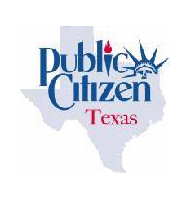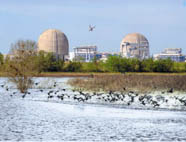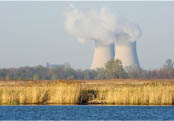Author Archive
Three Mile Island
Pennsylvania Highways
October 29, 2007

Before March 28, 1979, hardly anyone aside from those living in Central Pennsylvania, knew where Three Mile Island was located. However, after that date, anyone in the world with access to a TV, a radio, or a newspaper could take a map of Pennsylvania and point to a sandbar in the middle of the Susquehanna River.
The TMI-2 reactor had just come online in December 1978, and was the same design as the reactors of the Shippingport Nuclear Power Plant near Beaver. The accident began in the early morning of March 28, when a little after 4:00 AM, pumps supplying water to TMI-2’s steam generators tripped. With no water, there would be no steam, and therefore the plant’s safety system kicked into action and shut down the steam turbine and the generator it powered. The nuclear reactions in the core continued until the system dropped the control rods into the core to halt the fission process, which is a process called “scramming.” Even with the control rods in the core, heat continued to rise because decaying radioactive materials left from the fission process continued to heat the water.
The accident fell into the laps of four men: William Zewe, shift supervisor for TMI-1 and TMI-2; Fred Scheimann, shift foreman for TMI-2; and two control room operators, Edward Frederick and Craig Faust. Each man had been trained by Metropolitan Edison and Babcock & Wilcox and licensed by the NRC. However, nothing in their training had prepared them for this problem.
The first word of the accident came at 8:25 AM, with a report from WKBO-AM in Harrisburg. Using a yellow Camero with a CB radio, the station’s traffic reporter Dave “Captain Dave” Edwards relayed information that police and fire fighters were mobilizing in Middletown. He also mentioned that there was no steam emanating from the plant’s cooling towers. Mike Pintek, then WKBO’s news director and who would later move onto KDKA-AM in Pittsburgh, called the plant to speak to someone in the public relations office. The receptionist, hurried as she was, instead connected him to the control room to a man who said, “I can’t talk now, we’ve got a problem. Call Reading and talk to them.” The man denied that “there are any fire engines,” and told Pintek to telephone Met Ed, owners of the plant, in Reading.
Victory in Landmark Clean Water Act Challenge
BLUE RIDGE ENVIRONMENTAL DEFENSE LEAGUE
PO Box 88 ~ Glendale Springs, North Carolina 28629 ~ Phone (336) 982-2691 ~ Fax (336) 982-2954 ~ Email: BREDL@skybest.com
PRESS RELEASE
FOR IMMEDIATE RELEASE
FEBRUARY 20, 2009
Download in pdf format for printing.
CONTACT:
Louis Zeller (336) 982-2691 or (336) 977-0852
www.bredl.org
Victory in Landmark Clean Water Act Challenge
League and Lake Residents Overturn Dominion Nuke Permit
Today a Virginia court in Richmond ruled that state agencies violated federal law and that the water quality permit for Dominion-Virginia Power’s North Anna nuclear station is revoked. Judge Spencer ruled that Lake Anna water quality is governed by the federal Clean Water Act and that Virginia’s Attorney General was wrong in supporting the state’s water permit.
This landmark decision favored the Blue Ridge Environmental Defense League and co-plaintiffs residing near Lake Anna by determining that the so-called hot side of the lake is “waters of the United States.” The Virginia State Water Control Board must now go back to the drawing board to evaluate the adverse impacts of hot water discharges to Lake Anna from the two nuclear reactors.
Louis Zeller, Science Director of the League, said, “We and lakeside residents have long believed that Dominion is guilty of thermal pollution; however, we believe that the greatest impact of the Richmond court’s decision is that the Commonwealth and the people must reject the permitting of a third reactor at our endangered Lake Anna.”
The League is conducting research to see how many other power plants will be affected by this decision.
-end-
The Blue Ridge Environmental Defense League’s Petition for Appeal was filed in Circuit Court for the City of Richmond on December 28, 2007 pursuant to Virginia Code §§ 62.1-44.29 and 2.2-4026 and Rule 2A:4 of the Rules of the Supreme Court of Virginia. The appeal sought judicial review of the October 29, 2007 decision by the Virginia State Water Control Board to re-issue Virginia Pollution Discharge Elimination System Permit No. VA0052451 to Dominion-Virginia Power’s North Anna nuclear power plant Units 1 and 2.
Opposition to Expansion of South Texas Project
60-Day Clock For Nuclear Opponents Starts Ticking: Opposition to Expansion of South Texas Project in Place


For Immediate Release
February 20, 2009
Contacts:
Karen Hadden, Director, SEED Coalition, 512-797-8481
Susan Dancer, Director, South Texas Association for Responsible Energy, 361-588-2143
Cindy Wheeler, Consumers’ Energy Coalition, 210-367-8510
Matt Johnson, Public Citizen’s Texas Office, 512-637-9453
AUSTIN, TX The NRC posted notice today on the Federal Register regarding the opportunity to intervene in the application of South Texas Nuclear Operating Company (STPNOC) to build two reactors at the South Texas Project (STP) nuclear plant site, near Bay City. Citizens now have
only 60 days to prepare and present their legal case in opposition to the reactors. Citizen groups are opposing the proposed reactors, including the newly formed Bay City based organization, South Texas Association for Responsible Energy (STARE), Sustainable Energy and Economic Development (SEED) Coalition, Public Citizen, and others who will intervene in the case.
“New reactors would saddle homeowners and taxpayers with additional debt for infrastructure, more radioactive waste that would sit in our community, and more risk of nuclear accidents, health impacts and radioactive exposure” said Susan Dancer, Director of the South Texas Association for Responsible Energy in Bay City, Texas. “These are among the many reasons we will intervene in opposition to more nuclear reactors.”
“CPS Energy has been stealthily and irresponsibly getting San Antonio deeper and deeper into this nuclear boondoggle, which is already raising our utility rates," said Cindy Weehler of the Consumers’ Energy Coalition. “There are cleaner, more affordable ways to generate electricity. Energy efficiency should be prioritized, not put on a back burner. With the economic downturn, we shouldn’t generate power that’s not needed. San Antonio has reduced energy use by 16% over the past two years. Why should we even consider antiquated reactors that could cost $17.5 billion and would leave radioactive waste for generations to come?”
“The streamlined combined construction and operating license process is designed to cut citizens out and limit public involvement. Safety concerns are taking a backseat to cost-cutting measures and the public doesn’t even know it yet.” said Karen Hadden, Executive Director of the Sustainable Energy and Economic Development (SEED) Coalition.
Nuclear opponents point out the troubled history of existing STP Units 1 & 2, reactors which ran six times over budget and were eight years late coming online. This sordid history includes harassment and illegal firing of employees who lodged safety complaints, theft of materials, subcontractor price-fixing schemes, and falsification of quality assurance/quality control reports. Before either unit was in operation The Austin Light newspaper reported on February 17, 1988, “There are currently more than 650 allegations concerning safety, costs and criminal activities brought by people who have worked on the project.” NRC Region IV became a target for a US Senate committee investigation for “corrupt” oversight of construction practices at STNP and Comanche Peak, another Brown and Root project. Sen. John Glenn said the agency is “more lapdog than watchdog.”
STPNOC includes NRG and CPS Energy, the municipal utility in San Antonio. Austin Energy, a partner in existing reactors at the site, has declined to participate in the proposed expansion. An indefinite suspension of the license hearing was obtained through a petition SEED Coalition filed last year, based on the incomplete nature of the application. That suspension has now ended with the notice issued today by the NRC on the Federal Register regarding the public’s opportunity to request participation in the hearing regarding the South Texas Project COL. The deadline for filing a request to participate is April 21. Citizens must develop their contentions, their legal case, during this extremely short time period, despite the fact that further revisions of the application are still anticipated.
The notice is entitled “South Texas Project Nuclear Operating Company Application for the South Texas Project Units 3 and 4; Notice of Order, Hearing, and Opportunity To Petition for Leave To Intervene”. This federal register notice was published as Volume 74, No. 33, pages 7934-7938.
The federal register notice along with information regarding the history of the existing ST(N)P reactors will also be posted at www.NukeFreeTexas.org.
South Texas Nuclear Project-The Record

NRC Image of South Texas Project, Units 1 & 2
The controversial nuclear power plant was delivered more than five times over the construction budget and seven years behind schedule.
STNP began construction in 1976, with a promised completion in 1981. Instead, Unit 1 construction was finished seven years late in 1988, and Unit 2 in 1989.
The initial cost estimate made in Dec. 1973 was $964 million-but actual costs ballooned more than five-fold to $5.5 billion.
History of a Troubled Project
Dec. 6, 1971 Houston Lighting & Power Co. (HL&P), the City of Austin, the City of San Antonio, and the Central Power and Light Co. (CPL) initiate feasibility study of constructing a jointly-owned nuclear plant.
1972 A construction company, Brown and Root (Halliburton), lobbies HL&P to win the STNP contract. B&R states in a letter to the utility that the project can be completed for $424 million and offers a $1 million "inducement" check to HL&P.
Sep. 9, 1972 Austin voters decline $289 in bonds for STNP participation.
May 15, 1973 Austin Mayor Pro-Tem Dan Love says the city’s failure to approve nukebonds is "tragic."
Jun. 6, 1973 HL&P and CPL announce their plans to build the South Texas Project nuclear plant in Matagorda County on the Texas coast. The initial official cost estimate for the plant: $964 million.
Jun. 28, 1973 The San Antonio City Public Service (CPS) Board signs a participation agreement to become an owner of STP.
Aug. 6, 1973 Brown & Root named project engineer and constructor.
Sep. 5, 1973 Austin Chamber of Commerce urges STNP participation, saying this is the only way to meet projected demands for electricity in 1982.
Nov. 18, 1973 Austin voters narrowly approve participation in STNP.
Dec. 1, 1973 Austin signs nuke contract with HL&P.
May 19, 1974 Application for plant construction permit submitted to the Atomic Energy Commission, predecessor agency to the Nuclear Regulatory Commission (NRC).
Dec. 22, 1975 NRC issues construction permits for Unit 1 and 2. HL&P is to be managing utility partner for construction and operation.
Sep. 24, 1981 Project completion is forecast for June 1989-four years behind schedule. More cost overruns are announced, with final costs estimated at $4.4 to 4.8 billion, more than four times initial estimates. Brown and Root gets fired as architect. Bechtel Energy Corp. is hired as project’s new architect/engineer. Brown & Root remains on as project builder.
Dec. 26, 1981 Owners commence breach of contract lawsuit against Brown & Root, which then withdraws as the project’s construction contractor.
Nov. 3, 1981 Austin voters authorize sale of the city’s 16 percent interest in the STP. No buyers are found.
Feb. 15, 1982 Ebasco Constructors hired to replace B&R as construction contractor.
Jan. 6, 1983 City of Austin sues HL&P for alleged mismanagement of construction.
May 30, 1985 A settlement of the Brown & Root lawsuit with project partners is announced. B&R agrees to pay STNP’s owners $750 million.
Jul. 2, 1986 Audit by Texas Public Utility Commission (PUC) finds that $1.1 to $1.3 billion of $5.5 billion construction costs were due to "imprudent mismanagement." PUC says these figures are over and above the $750 million provided by B&R in settlement.
1987 A Washington, DC watchdog group, the Government Accountability Project (GAP), receives complaints of safety related defects in construction and engineering from three dozen former and current project employees. Alleged crimes committed include: harassment and illegal firing of employees who lodged safety complaints; theft of materials; subcontractor price-fixing schemes; and falsification of quality assurance/quality control reports.
Aug. 12, 1987 Additional overruns of $100 million announced, bringing total project pricetag to $5.5 billion. San Antonio Mayor Cisneros vows to sue HL&P if further overruns occur.
Sep. 1987 Austin reaches tentative agreement to give HL&P its share of STNP in exchange for 400 megawatts of replacement power. Austin’s City Council refuses to hold hearings on GAP allegations to keep the negotiations alive. The deal ultimately comes apart when other partners refuse to share any costs of settlement with HL&P.
Oct. 16, 1987 PUC conducts hearings on STNP. The agency says a finding on whether or not it is economical to finish Unit 2 will be delivered in 1988-three years after PUC first ordered the study. Contrary to Mayor Cisneros’ professed dissatisfaction, the San Antonio Express News reports that CPS told the PUC that it is "satisfied with STP progress."
Nov. 8, 1987 San Antonio Express News says fifty-seven plant employees are alleging widespread and serious safety hazards in a ‘whistleblower’ complaint to the NRC. HL&P admits to the federal agency that two of their workers falsified inspection reports.
Mar. 8, 1988 Unit 1 goes critical; enters commercial operation on Aug. 25.
Mar. 18, 1988 NRC fines HL&P $75,000 for safety violations.
Feb. 17, 1988 The Austin Light newspaper reports, "There are currently more than 650 allegations concerning safety, costs and criminal activities brought by people who have worked on the project." NRC Region IV becomes a target for a US Senate committee investigation for allegedly "corrupt" oversight of construction practices at STNP and Comanche Peak, another B&R project. Sen. John Glenn says the agency is "more lapdog than watchdog."
Jan. 1989 Fire causes a leak and loss of cooling, causing reactor scram.
Mar. 12, 1989 Unit 2 reached initial criticality; goes into commercial operation Jun. 19.
Jul. 15, 1989 State court in Dallas unanimously rules HL&P doesn’t owe Austin any damages for construction project mismanagement.
Mar. 1991 Cracked fuel injector nozzles are found and have to be replaced.
Dec. 1991 Valve fails to open, a causing rapid decrease in reactor pressure and forcing a scram.
Dec. 1992 STNP management claims records for electric generation by a Westinghouse reactor in a single fuel cycle (Unit 1) and for a US reactor in a calendar year (Unit 2). However, in late December, a series of pump malfunctions begins in both units.
Feb 1993 Both units are taken offline to resolve problems with steam-driven auxiliary feedwater pumps. They will not return to service until March (Unit 1) and May (Unit 2) of 1994. NRC fines HL&P $500,000 for safety violation and places STNP on a "watch list" of facilities with serious safety-related issues.
Feb. 16, 1994 NRC chair Ivan Selin tours STNP and declares plant "as well designed and as good a physical facility as there is in the United States."
Feb. 22, 1994 City of Austin sues HL&P for $120 million in damages resulting from the shutdown, including $51 million in higher electricity costs for utility customers.
Dec. 31, 1995 STNP management claims national and global records for electric generation due to improving operations.
May 1, 1996 HL&P and the City of Austin reach an out-of-court settlement. Austin agrees to drop all litigation against HL&P; both parties agree to form a separate operating company to run STP.
Dec. 1996 Control rods for Unit 1 fail to insert properly into reactor core.
Jul. 1999 Emergency diesel generator is inoperable for three days.
Dec. 2002 Four massive steam generators are replaced in Unit 2.
2003 Unit 1 shut down after inspection during refueling reveals coolant leaks.
Feb. 9, 2005 Unit 2 shut down due to cooling system leaks.
Jun. 19, 2006 NRG Energy files a Letter Of Intent with the NRC to build two 1358-Mwe Advanced Boiling Water Reactors at the South Texas Project site.
Sep. 24, 2007 NRG filed a full application with the NRC to build two GE ABWRs at the STNP site. This is the first full application for a new reactor to the NRC since 1979. The proposed expansion would generate an additional 2,700 MW of electrical generating capacity, doubling the size of the existing STNP complex.
Dec. 11, 2007 San Antonio Express News says, "Planning for an addition to the South Texas Project nuclear plant is costing CPS Energy $206 million." The newspaper reports CPS contributed half of $80 million for the NRC application.
Cancer questions grow around Fermi
Cancer questions grow around Fermi nuclear plant
State health report shows 31 percent increase in cancer rate among young people in Monroe County since 1996

2/17/09
By Eartha Jane Melzer
Michigan Messenger
The cancer rate among people under the age of 25 in Monroe County rose at more than three times the rate of the rest of the state between 1996 and 2005, according to a report generated by the Michigan Department of Community Health (MDCH). Between 1996 and 2000, the average rate of cancer cases for this group was 18.5 cases per 100,000 people; between 2001 and 2005, the rate grew to 24.3 per 100,000. Between 1996 and 2000 the statewide rate of cancer for this group was 20.2 per 100,000; between 2001 and 2005, the rate was 21.9.


